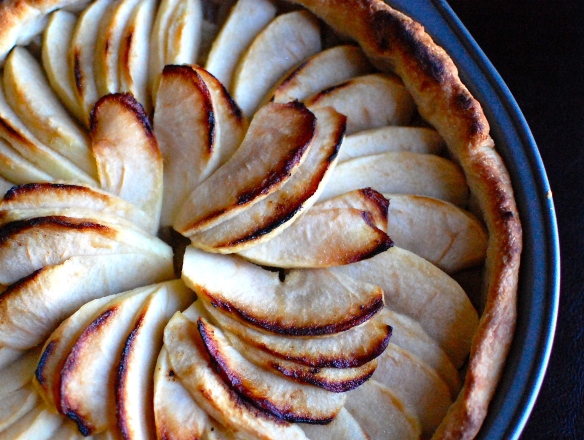
Let me tell you one thing: Perfection is to be found between the texture of a croissant and the taste of a salted caramel. It’s called kouign amann (kween a-mon). Don’t let yourself be scared by this unpronounceable name. In the Breton language “kouign” means cake and “amann” means butter. That says it all. Imagine layers of laminated dough filled with butter, topped with a little bit of salt and enveloped in a beautifully caramelized shell.

I was recently struck by the sudden fuss around this typical buttery pastry from the Brittany region of France. If you’re in Seattle, you can find this little wonder at Le Rêve Bakery or Crumble and Flake. Part of my family being from Brittany, I felt it was my duty to test the field. My general impression? They’re rather good, but compared to the original, one thing comes to my mind: Not. Enough. Butter.
Since then, I’ve been obsessed with trying to find the perfect recipe for kouign amann — and believe me, it took a lot of dedication and sacrifice. I won’t disclose the total amount of butter I used over the last two months, all in the name of research. And if you ask, yes, my cholesterol level is fine, although I wonder if my husband’s decision to start running again is related to me feeding him with sticks of butter. I ended up sharing part of my batches with friends and colleagues who I hope won’t hold it against me if their cholesterol spikes.

I wish I could share with you a family recipe, but my knowledge of the kouign amann is limited to the ones we used to buy at the farmers markets. My older sister, who has Breton blood running in her veins (long story short, we share the same father but it’s her mother who comes from Brittany), introduced me at a very young age to this cake. When I told her I would try to make one, she laughed. My mother’s family is three generations removed from Brittany, so apparently I lack the necessary heritage. But I insisted and maintained I would do it with or without her help. (Imagine this conversation happening on Skype with an ocean separating us.)

She finally agreed to go ask her baker for advice. I could already picture myself making a true kouign amann but was slightly disappointed when she did not get the exact recipe. The recipe her baker uses for kouign amann is a secret apparently shared with very few people, and I was not among those lucky folks. The baker nevertheless gave us the best advice I could have hoped for, which perfectly summarizes the spirit of this cake: When you’re done adding butter and sugar to your dough, add some more. The kouign amann must perspire butter.

Rule number one, and I won’t accept any excuses: Use good quality butter. Salted butter is usually recommended as salt is at the very heart of Breton baking. I personally prefer using unsalted butter and sprinkling fleur de sel afterwards. Fleur de sel (flower of salt) is one of the finest salts you will find. It is hand-harvested in salt ponds mainly in Guérande, Noirmoutier and Île de Ré. As suggested by its name, its texture is fluffy and flaky but delicate. It has a complex and mineral flavor, less aggressive than other salts. It’s perfect for sprinkling over meat and fish or creating a contrast with the sweetness of a dessert. Don’t hesitate to splurge if you see it; you will never look at your regular table salt the same way.

Salt ponds at Île de Ré
Ingredients
Yields 12 mini kouign amann
- 7 g (1 package) active dry yeast
- 2/3 cup lukewarm water
- pinch of sugar
- 1 tbsp. butter, melted
- 2 cups (260 g) all-purpose flour + additional for rolling out the pastry
- pinch of sea salt
- 1 stick + 6 tbsp. butter, for laminating, chilled
- fleur de sel, to taste
- 1 cup (200 g) sugar, for laminating
- 2 tbsp. butter, for muffin pan
- 2 tbsp. sugar, for muffin pan
- 2 tbsp. butter, for topping the cakes

In a medium bowl, dissolve the yeast in the water with a pinch of sugar. Stir and let stand for about 5 to 10 minutes, until foamy. Gradually add the flour, salt and melted butter. Flour your hands and briefly knead the dough until it gets soft and elastic. Add a little bit of flour if it gets too sticky. Don’t knead the dough too much. Overworking it will activate the gluten and result in a product that’s tougher and less light and flaky. As soon as the dough is smooth and elastic, stop kneading.
Form a ball and, with a knife, score the top of it the dough the shape of a cross and put it in a greased medium bowl. Cover with cling film and refrigerate for about 1 to 1 1/2 hour.
In the meantime, prepare the butter. The butter should be cold but pliable. Cut it in pieces and form a square.

Cover with parchment paper and use your rolling pin to spread it in a 8″ x 9″ square.

Take the dough out, lightly flour it and roll it out to form a rectangle that’s about 18″ x 9″ in dimension. Place the butter in the center, sprinkle with fleur de sel and fold both sides of the dough over the butter, so that they meet in the center.

Rotate the dough 90º clockwise and gently roll the dough, always starting from the center and working your way to one side and then to the other, until obtaining a rectangle approximately 18″ x 9″ in dimension. Dust the surface of the dough with a third of the sugar.

Fold the dough over the center in such a way that one side of the dough is covered by the other side. Congratulations, you just made a single fold! Cover with cling film and refrigerate for about 30 minutes.

Turn the dough 90° clockwise again and roll it to form a rectangle of about 18″ x 9″. Dust with the second third of sugar and fold it into thirds again. Refrigerate for about 30 minutes.
Rotate again by 90° and roll again to reach approximately the same size and shape as before, dust with the rest of the sugar and fold it again like a letter. Place in the fridge for 30 minutes.
While the dough is resting, prepare your muffin pans. Brush with butter before coating with sugar.

Take the dough out of the fridge, roll it into the usual rectangle and cut it into 12 squares. For each square, fold the corners towards the center and place into the prepared pan to proof.

Alternate version: You can also cut vertical strips and roll them up, cinnamon roll-style.

Let the dough rest at room temperature for 20-30 minutes. Preheat the oven to 350 °F. Sprinkle each mini kouign amann with sugar, top with a little bit of butter and bake for about 25 to 30 minutes, until golden brown and caramelized. Remove from pan and let cool on a wire rack.
Put your diet on hold and be ready to fall in love.

Keep in mind that your dough does not have to be as perfectly rolled as puff pastry. Worst case, if you see that the rolling is not going well, you can stil put the whole thing into a big pan and cook it as such. After all, what can go wrong with yeasty dough, butter and sugar?
Bee




























